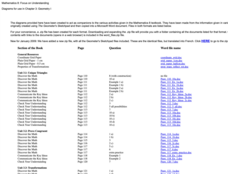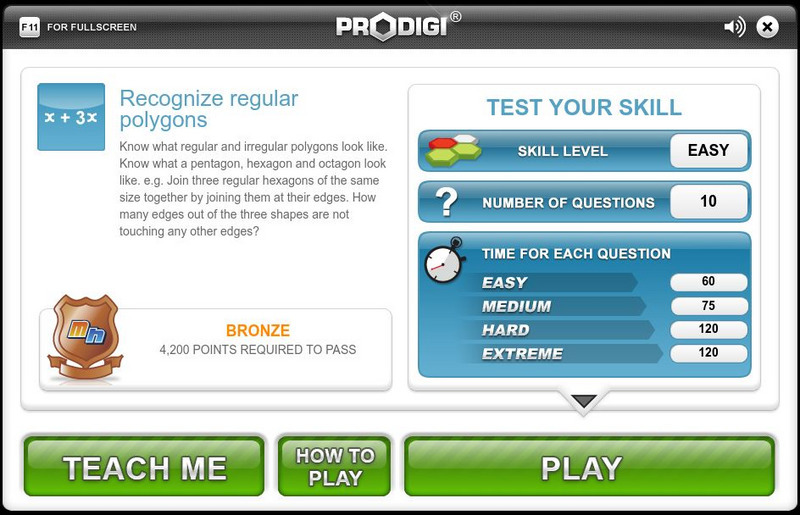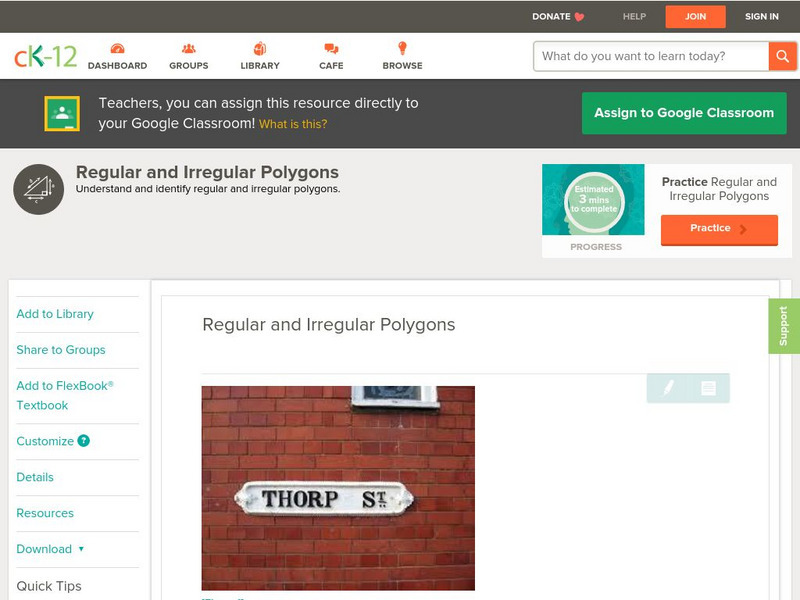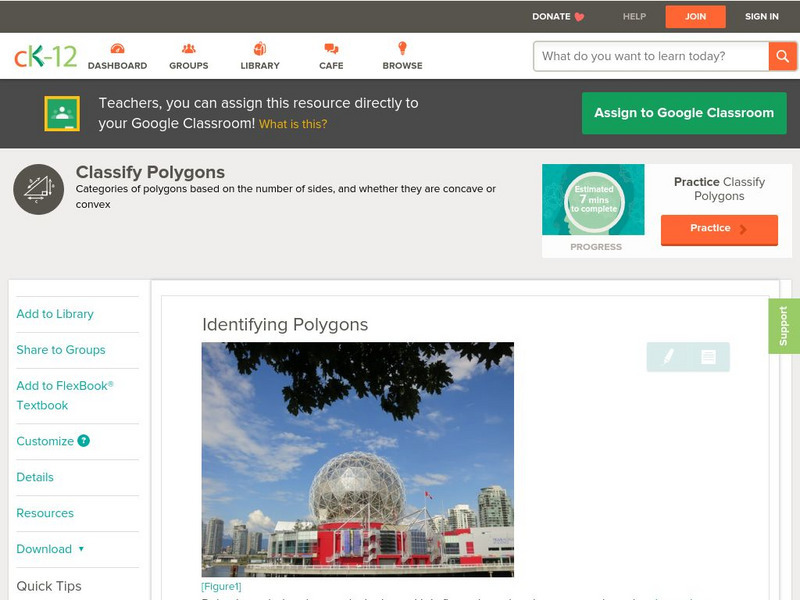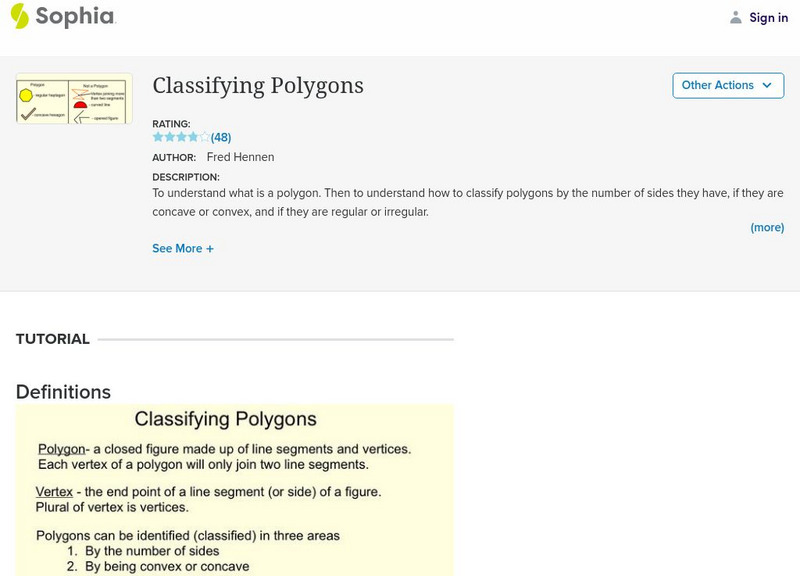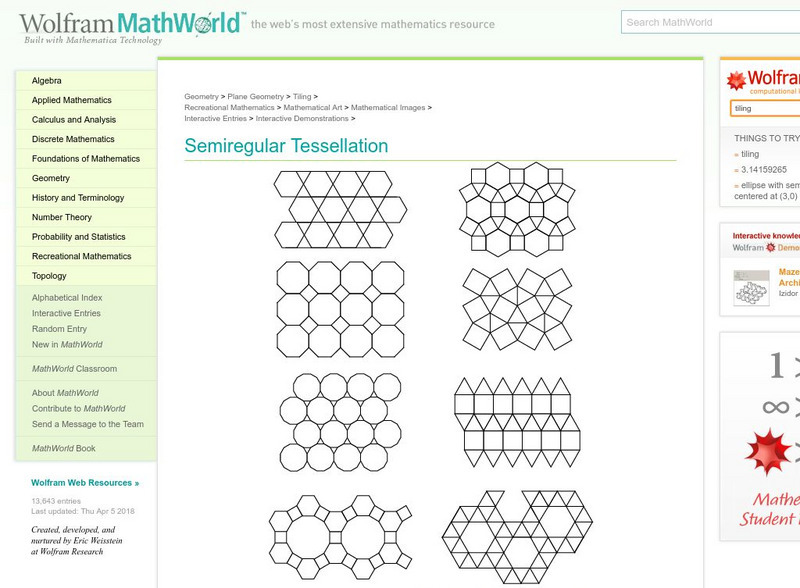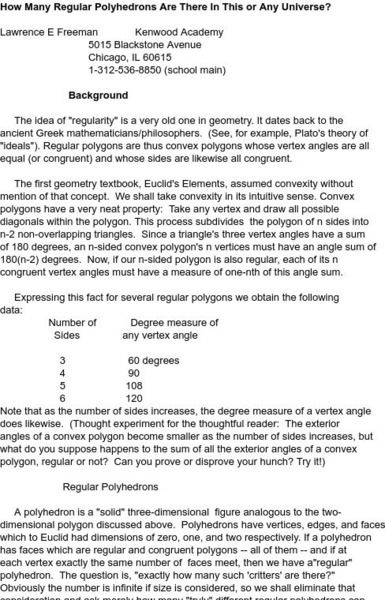Texas Instruments
Texas Instruments: Ratios in Regular Polygons
In this activity, students use linear measurement and calculators to investigate the ratios between corresponding parts of regular polygons.
Texas Instruments
Texas Instruments: Numb3 Rs: Regular Polygon Centroids
Based off of the hit television show NUMB3RS, this lesson shows students different ways to find centroids of regular polygons. The traditional way (using medians) is presented, as well as the triangulation method, the diagonals method,...
Texas Instruments
Texas Instruments: Discovering Geometry: Drawing Regular Polygons
Students will explore the central angles of a regular polygon.
Math Is Fun
Math Is Fun: Regular 2 D Shapes
This tutorial provides illustrations for regular 2-D shapes as well as a definition for polygons and for regular polygons.
PBS
Pbs Mathline Lesson Plan: Mirror, Mirror [Pdf]
The goal of this PBS lesson is for young scholars to apply spatial reasoning, problem solving, and critical thinking skills to assess which regular polygons will tessellate. A detailed lesson plan that includes related worksheets, lesson...
PBS
Pbs: Mathline: Tessellations Wow! [Pdf]
An integrated geometry lesson on spatial sense in which young scholars identify and use different shapes to create a tessellation. "Through a variety of modalities such as writing, music, art, poetry, and literature, students are...
Curated OER
Nova Scotia Dept. Of Education: Mathematics 8: Geometry Diagrams
A collection of diagrams that complement Mathematics 8, a Grade 8 Math text, have been posted here. The diagrams were created using The Geometer's Sketchpad,
CK-12 Foundation
Ck 12: Geometry: Regular and Irregular Polygons
[Free Registration/Login may be required to access all resource tools.] Identify regular polygons and their characteristics
Math Is Fun
Math Is Fun: Properties of Regular Polygons
Find a definition of regular polygon, and learn how to calculate the internal angle, external angle, and number of diagonals of a regular polygon. Also, learn how to find the area of regular polygons.
CK-12 Foundation
Ck 12: Geometry: Polygon Classification
[Free Registration/Login may be required to access all resource tools.] Identifying polygons, their diagonals and their angles
Sophia Learning
Sophia: Classifying Polygons
This lesson explores the characteristics of various types of polygons. It includes two PowerPoint presentations that test students' understanding by grouping polygons in the correct categories.
CK-12 Foundation
Ck 12: Geometry: Regular and Irregular Polygons
[Free Registration/Login may be required to access all resource tools.] Understand the difference between regular and irregular polygons.
Analyze Math
Analyze Math: Polygons Problems
Here are four problems about the area of a regular polygon. Start by finding the area of a hexagon inscribed in a circle of radius 10, and end by proving that as the number of sides of the polygon increases, the area of the polygon...
National Council of Teachers of Mathematics
The Math Forum: What Is a Tessellation?
The Math Forum defines and illustrates geometric tessellation.
Analyze Math
Analyze Math: Regular Polygons
The interactive tutorial examines the properties and formulas of regular polygons, inscribed circles, and circumscribed circles.
CK-12 Foundation
Ck 12: Geometry: Interior Angles in Convex Polygons
[Free Registration/Login may be required to access all resource tools.] This concept teaches students how to calculate the sum of the interior angles of a polygon and the measure of one interior angle of a regular polygon.
Math Open Reference
Math Open Reference: Area of a Regular Polygon
A complete reference guide to the area of a regular polygon. It provides definitions, examples, and an interactive activity that enhances further explanation. Includes links to related topics.
Math Open Reference
Math Open Reference: Interior Angles of a Polygon
Learn about interior angles of a polygon with this handy reference guide. Provides a detailed definition, examples, and an interactive activity that enhances further explanation. Includes links to related topics.
Math Open Reference
Math Open Reference: Regular Polygon
A complete reference guide to regular polygons. It provides definitions, examples, and an interactive activity that enhances further explanation. Includes links to related topics.
Quia
Ixl Learning: Perimeter
Brush up on your math skills relating to perimeter then try some practice problems to test your understanding.
Quia
Ixl Learning: Regular Polygons
Brush up on your math skills relating to regular polygons then try some practice problems to test your understanding.
Wolfram Research
Wolfram Math World: Semiregular Tessellations
This one page Mathworld site has a number of examples of semiregular tessellations. A definition and a small amount of related information is given at the bottom of the page.
Science and Mathematics Initiative for Learning Enhancement (SMILE)
Smile: Polyhedrons
This in-depth paper examines the idea of convexity. Euclid's Elements, the first geometry textbook, assumed convexity without mentioning the term.



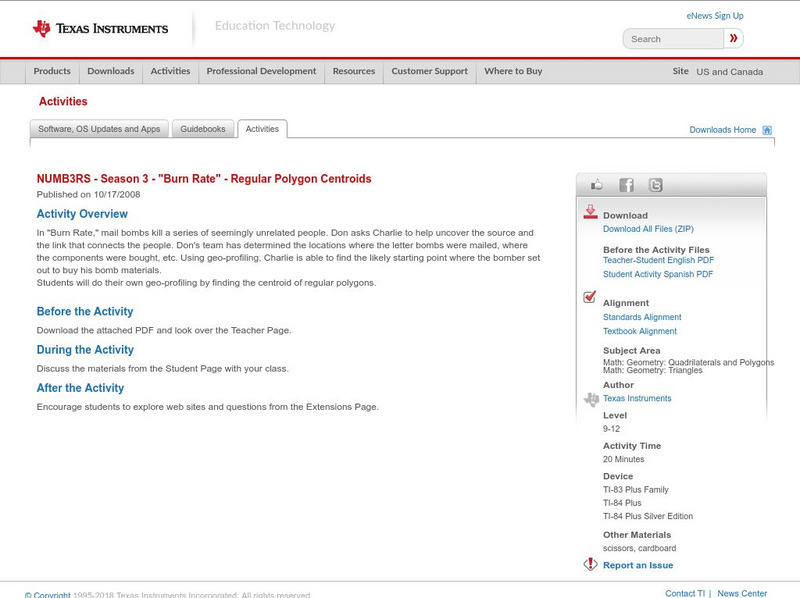


![Pbs Mathline Lesson Plan: Mirror, Mirror [Pdf] Lesson Plan Pbs Mathline Lesson Plan: Mirror, Mirror [Pdf] Lesson Plan](https://d15y2dacu3jp90.cloudfront.net/images/attachment_defaults/resource/large/FPO-knovation.png)
